When it comes to outfitting your kitchen, the appliances you choose matter. Not only do they contribute to the look and feel of your home, but also how well you can manage day-to-day tasks in the kitchen. From choosing a refrigerator for fresh food storage to selecting a dishwasher that can handle all your dirty dishes with ease - here are some tips on how to pick the best kitchen appliances for your home as part of an efficient workflow system
Research the features you need - Do you want a gas or electric stove, built-in appliances, or a refrigerator with an ice maker included?
Researching the featu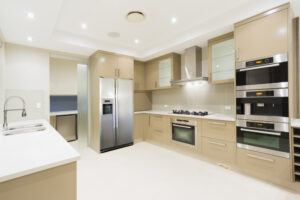 res of each item is key to obtaining the perfect appliances for your needs. For example, do you prefer a gas or electric stovetop? If you like built-in options, then consider if they're available in the style and size that will fit your kitchen space. It's also essential to think about extra features such as an ice maker in the refrigerator. Once you've determined what works best with your home and lifestyle, you'll make an informed decision about which appliance will be perfect for your new home.
res of each item is key to obtaining the perfect appliances for your needs. For example, do you prefer a gas or electric stovetop? If you like built-in options, then consider if they're available in the style and size that will fit your kitchen space. It's also essential to think about extra features such as an ice maker in the refrigerator. Once you've determined what works best with your home and lifestyle, you'll make an informed decision about which appliance will be perfect for your new home.
Consider your lifestyle - Will you be cooking often or do you just need basic kitchen appliances
Choosing the right kitchen appliances for your home is an important decision to make, and it really comes down to considering how you live. If you're a culinary enthusiast who'll be hosting dinner parties and cooking large meals, then making sure you have the right tools to make your vision come true will be very important. You’ll want to ensure that you buy top-of-the-line appliances that can handle whatever meal idea you come up with. On the other hand, if cooking isn't something that fits into your lifestyle at the moment, then investing in more basic kitchen appliances may be a wiser choice. As long as they do their job properly, then there's no need to buy sleek and fancy equipment. However, no matter which type of kitchen appliance buyer you are, always make sure that your new pieces can integrate into your space as logically and efficiently as possible.
Compare prices and read customer reviews - Check multiple stores and websites to find the best deal and make sure they offer good customer service
When shopping for the best kitchen appliances for your new home, it pays to compare prices and read customer reviews. Look at multiple stores and websites in order to get the best deal. Pay extra attention to customer service ratings, as they could be indicative of how well the company handles any issues that may arise with your purchase. Prioritizing quality products, reliable customer service, and good value will go a long way toward helping you make a smart choice when it comes to finding the perfect appliances for your new kitchen.
Measure your space - Make sure the appliances will fit in the designated area of your kitchen
When selecting kitchen appliances for your home, it's important to factor in the size of the space you have available. An oversized refrigerator may be great for stocking up with plenty of food, but if your kitchen lacks adequate space it'll take up most of the room! Make sure the height, width, and depth of each appliance you're considering will comfortably fit in the designated area of your kitchen before making a decision. Knowing the exact measurements of your kitchen can help ensure you don't choose appliances that are too large - allowing you to create an efficient and inviting cooking oasis.
Pay attention to energy efficiency ratings - Look for ENERGY STAR® certified appliances, which use less energy
Energy efficiency ratings should always be taken into consideration when purchasing kitchen appliances for your new home. Look for ENERGY STAR® certified appliances, as these consume at least 10-50% less energy and water compared to standard models. Reducing your energy output will not only help reduce your energy bills each month but also help the environment. Plus, you might even qualify for additional incentives offered by the government when choosing an ENERGY STAR® certified appliance. Investing in a product with an exceptional energy rating is important to protect both your wallet and our planet.
Ask about installation options – See if any retailers offer free installation or delivery services.
When making decisions about which kitchen appliances to select for your new home, asking retailers about installation options can be a great way to save time and money. Many stores offer free or discounted installation services and delivery, so it’s worth inquiring if any deals are available. Additionally, some shops may have packages and bundles that pair discounted appliances with installation, allowing you to get the job done quickly and easily. Shopping around is the best way to determine exactly what offers might be available.
Here are some of our current favorites when it comes to kitchen appliances (quality & design):
The Bottom Line
Taking the time to shop for the right kitchen appliances is vital for creating a kitchen space that works for you and your family. Regardless of whether you're replacing old appliances or starting from scratch, ask yourself what features you need and how they'll fit into your home and lifestyle. Do your research to compare prices, read customer reviews, and look for energy efficiency ratings. Consider if any retailers offer free installation or delivery services. With all these pointers in mind, you can be sure to find the perfect appliance that both fits your budget and enhances your living space with ease.
As we begin a new year, many homeowners are considering making updates to their homes. One of the biggest changes you can make to increase the look and feel of your space, as well as the value of your home, is installing new flooring. Before you break out the jackhammer, read on to learn more about what products are hot and how much new flooring in Arizona may cost you.
While it may be very exciting to get new flooring, before applying any new materials (for the most part) the old flooring needs to be removed prior to installation. As you are calculating the cost of new flooring for your home, be sure you factor in the cost of removal:
Average Cost to Demo Hardwood: $4 SQFT
Average Cost to Demo Tile: $3.25 SQFT
Average Cost to Demo Engineered Hardwood: $4 SQFT
Average Cost to Demo Vinyl: $1 SQFT
If you have tile in your home that needs to be removed, you can opt for a “dustless” removal process that helps keep your home clean and free of all debris that goes along with removing old flooring. On average, dustless removal will be $2 to $3 dollars more vs. standard removal techniques.

There are so many uses for vinyl flooring; it’s no wonder that it’s rising fast as an affordable, sustainable, and fashionable option.
Vinyl is durable and easy to clean while often less expensive and more available than other flooring options. While vinyl used to be an immediate throw-away from outmoded 70’s design, modern technology has changed the uses of vinyl. From one large sheet of cheap flooring, luxury vinyl now offers an endless array of designs and textures to mimic wood and stone.
Luxury vinyl typically falls into two categories: planks and tile. The main difference between a plank and a tile is its dimension, with a plank having a rectangular shape and a tile a square shape.
Vinyl planks are often used to imitate a hardwood floor at a fraction of the price and a limitless array of colors, widths, and textures. You can get luxury planks that appear hand-scraped or wire-brushed. If you prefer neutral grays, you’ll find those shades too! You can even get planks crafted with a micro bevel on the edge of each plank, making it seem like your floor is genuine wood.
While vinyl planks can also imitate stone, it’s more common to see stone textures in vinyl tiles. Vinyl tiles are a great, durable option for kitchens and bathrooms in particular! Add some grout for a professional finish that could dupe for real marble or stonework.
Luxury Vinyl Pricing
Average professional install per square foot: $3 SQFT
Average price per square foot for materials: $2-$5 SQFT
Average total cost: $8 SQFT
Engineered hardwood is an excellent option if you want to incorporate real wood but still keep costs down. Engineered hardwood has two parts-- the veneer and the core. The veneer is the thinnest part that shows the desired color and texture. The core is made of less pretty wood but offers the long-lasting durability you need from your floors.
There are a few different kinds of hardwood that will change the location and ease of install.
Last is the easiest and newest option-- the click-lock method. Click-lock planks have grooves that easily fit together and stay locked once placed. It’s become an increasingly popular option since you can ditch the glue and nails and works equally well on cement and wood subfloors. It also makes it easiest to replace small sections if damaged!
Engineered Hardwood Pricing
Professional Install: $4 SQFT
Price per square foot: $6-$10 SQFT
Average cost: $14 SQFT
If you’ve got the budget, nothing can truly replace authentic porcelain or ceramic tile. These tiles can be handcrafted in a variety of shapes and sizes. If you’re going for a more customized look, these tiles can make a great statement.
While each tile material has its place, it’s important to note that porcelain and ceramic options are not interchangeable. Porcelain tiles are rated at a greater hardness, meaning that they are less likely to break and chip when used on the floor. Ceramic tiles are softer, so you’ll likely have a smaller range of selection approved for flooring.
Porcelain price per square foot: $2-$30, but most people spend between $3-$10
Porcelain Professional Install: $4.25 - $10 per square foot
Ceramic tile per square foot: $0.50-$35
Ceramic Professional Install: $4-10 per square foot
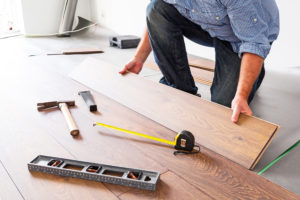
The price of your hardwood floors can range dramatically depending on the class of wood you’re looking for. Most commonly purchased hardwoods range from $6 to $12, making them competitively priced with vinyl options. Still, if you prefer more exclusive or exotic woods, you can quickly go over $40 per square foot.
Installation costs are similar to the cost of engineered hardwood. However, keep in mind that more intricate patterns-- like herringbone-- will cost more.
Finally, hardwoods can require more maintenance than other types of flooring. They can be at higher risk for scratches and warping (clean liquid spills immediately). Real hardwood floors offer a luxe look but may not be practical for homes with small children or pets.
Professional Install per square foot: $8 to $18 SQFT
Price per square foot: $6-$12, up to $40+ for exotic flooring
Average cost for new hardwood floors: $14 to $35 per square foot
Pro Tips:
Need Help Narrowing Your Options?
There are so many great and affordable flooring options now available, so it can be challenging to know which product will be the best use of your time and money. You may also need help determining how your flooring will combine with your existing appliances, paint, finishes, and decor. Should you need assistance with picking out the perfect flooring for your home, don’t hesitate to reach out. We are happy to help!
It’s no secret that lighting can make or break the final design plan for any room. Lack of lighting, harsh lighting, or lighting that does not fit the overall aesthetic of the home, can turn a space into an unwelcoming hangout.
But, if you think of lighting as “jewelry” for the space, even in the most task-driven rooms, you’ll be able to create an environment that your family and friends will love.
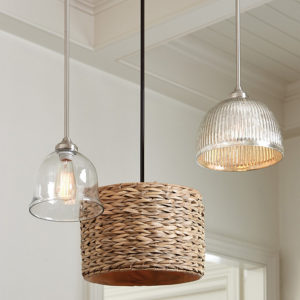 How you use your space should be one of the first considerations of what type of lighting you will need. Lighting for a kitchen will be much different than what you would choose for a bedroom or family room. Plan adequately for the spaces where you’ll need extra light for working. The mood of the room should also be considered when drafting your lighting plan. Areas that are used for relaxing or just hanging out may need some task lighting but should mostly rely on ambient lighting to set the mood.
How you use your space should be one of the first considerations of what type of lighting you will need. Lighting for a kitchen will be much different than what you would choose for a bedroom or family room. Plan adequately for the spaces where you’ll need extra light for working. The mood of the room should also be considered when drafting your lighting plan. Areas that are used for relaxing or just hanging out may need some task lighting but should mostly rely on ambient lighting to set the mood.
Fundamentally, there are three categories of lighting that homeowners should focus on; ambient, task, and accent lighting. Unfortunately, one of the biggest design mistakes we see are rooms that only provide one source of lighting. Ideally, each room should have multiple sources of lighting to accommodate how the space is being used. Can lights, combined with floor and table lamps are ideal for family rooms, offices, and living rooms. Pendant lights combined with can lights and cabinet lighting are ideal for kitchens and bathrooms. Again, think about how space will be used and plan accordingly so that you have several options to choose from when you are in that room.
Total wattage/lumens and color of lighting are also very important considerations for any home. Task areas tend to require more wattage than relaxation rooms. The best way to determine how much lighting you need for a room is to take the total square footage of a room and multiply it by 1.5. So if your room is 12 x 15 (180 sq ft.) you would multiply 180 x 1.5 and get to 270 watts. The general lighting in the room will need to reach a minimum of the 270 watts mark to ensure there is plenty of overall light.
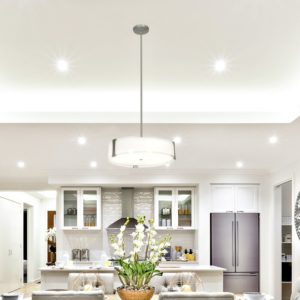 Recent trends allow for just about any kind of lighting to be mixed with different design styles. The key is to not let your lighting get overlooked. When updating a space, think beyond the hard surfaces, paint, and furniture. Many builders will typically install entry-level fixtures in order to save on cost. As the home ages, those fixtures become dated… and hated. Big box stores have several stylish lighting options for those working on a budget. You can also work with your interior designer or contractor to create a new lighting package to match your current style. No matter what you choose, just make sure all of your lighting coordinates with the overall look and feel you are trying to create.
Recent trends allow for just about any kind of lighting to be mixed with different design styles. The key is to not let your lighting get overlooked. When updating a space, think beyond the hard surfaces, paint, and furniture. Many builders will typically install entry-level fixtures in order to save on cost. As the home ages, those fixtures become dated… and hated. Big box stores have several stylish lighting options for those working on a budget. You can also work with your interior designer or contractor to create a new lighting package to match your current style. No matter what you choose, just make sure all of your lighting coordinates with the overall look and feel you are trying to create.
From chandeliers to pendant lights and everything in between, nothing is worse than walking into a room and having a light fixture overpower the space. Or be so small it looks like it was a mistake. Thankfully, some simple math will help you determine which light fixtures will be the best for your home:
Measure your room's length and width in feet and add those two numbers together. Then use that number as the width in inches for your chandelier. For example, if your room is 12' x 16', your chandelier should be 28" wide.
However, if you are placing the chandelier above a table, the width of the chandelier should be 12" narrower than the width of the table so no one bumps into it while getting in and out of their seat. Additionally, chandeliers should be placed 30 – 34 inches above a table to prevent them from interfering with site lines.
The number and placement of pendants over a stationary object are best determined based on the size of the object being highlighted. It is best to use an odd number of pendants over a table, countertop, desk, or end table. This technique creates a focal point and allows an even balance on each side. When hanging multiple pendants, the spacing should be determined by the diameter of the pendant.
Ideally, you will want the space between each pendant to be the same as the width or diameter of each fixture. For example, if you have 16-inch pendants, the space between each fixture should be 16 inches. This rule of thumb is still true, even if the pendants are hung at staggering heights. To figure out the proper size of your kitchen island pendants, follow the steps below:
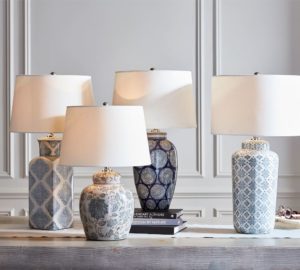 Lamps tend to come in three different categories: table, desk, and floor lamps. The height of the table lamp you pick is determined more by the room it sits in and the décor around the lamp. If you have a tall bedside table, then a shorter lamp will do and vice versa. The general norm here is to pick a lamp where the bottom of the shade is at your eye level when you are seated or resting. This works whether you are shopping for a table lamp that fits your reading nook, a bedside lamp, or even one that goes next to the couch in the living room.
Lamps tend to come in three different categories: table, desk, and floor lamps. The height of the table lamp you pick is determined more by the room it sits in and the décor around the lamp. If you have a tall bedside table, then a shorter lamp will do and vice versa. The general norm here is to pick a lamp where the bottom of the shade is at your eye level when you are seated or resting. This works whether you are shopping for a table lamp that fits your reading nook, a bedside lamp, or even one that goes next to the couch in the living room.
As a general rule of thumb, you determine how many canned lights you need by measuring the length and width of a room, as well as how high it is. Again, consider how the room will be used. We highly recommend putting all of your recessed lights on a dimmer switch so that you can modify, as needed. Additionally, consider different shades on the recessed lighting to accent walls, artwork, and other features within the room.
Still wondering what type of lighting designs will work best for your home? Feel free to contact us for an interior design service consultation or complete lighting package at info@macylanedesigns.com or via phone at 480-613-6537. We’d be honored to help you create your dream space.